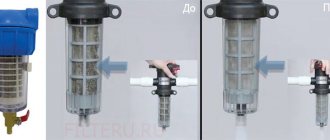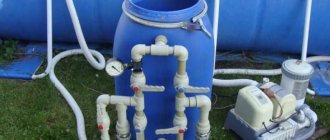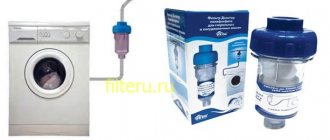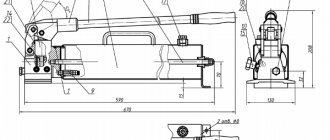In urban conditions, domestic standards allow water hardness levels of up to 7 mEq/liter. With such a content of calcium and magnesium compounds, you will have to descale the heating element of the washing machine monthly. Owners of private houses have to completely independently decide on cleaning issues. The use of an artesian well increases the concentration of these harmful impurities, since the liquid is saturated with them upon contact with dolomite and other rocks.
A salt water filter will help eliminate problems at minimal cost . It uses an inexpensive but quite effective filler made from polyphosphate compounds. Careful familiarization with this technology will help you make the right conclusion about the advisability of its use in specific situations.
Description of water softening with polyphosphates
The main part of the scale consists of calcium and magnesium compounds, which are initially dissolved in the liquid. Their presence is not detected visually. A specific taste is detected only at high concentrations.
Hazardous impurities exhibit harmful properties when the temperature rises. They are converted into solid, durable particles that attach to the walls of pipes and heating devices. This process has several harmful effects on the equipment:
- low thermal conductivity of the porous layer slows down heating and increases energy costs for performing work operations;
- insufficient heat removal provokes thermal destruction of individual structural elements;
- clogged ducts impair the efficiency of the boiler and washing machine and cause malfunctions in the electronic control circuits.
To prevent negative processes, polyphosphates are used. At a concentration in solution of 3.5-4.5 g per cubic meter. liquid will make a good water softener. These compounds form a thin film on the surface of microscopic particles, which prevents them from attaching to each other. It also prevents the formation and fixation of a layer on the walls of heat exchangers and other parts of the water supply/heating system.
An analogue of a salt filter - electromagnetic! It does not require the purchase or replacement of salt filling, and is also absolutely safe and harmless to the consumer!
An additional benefit is effective rust protection. This effect is achieved with a minimum (0.5-1.5 g per cubic meter) content of polyphosphates. Increasing the concentration to 2-3 g per cubic meter. prevent the destruction of parts by corrosive processes, which are activated by an excessive amount of chlorine compounds. The latter are still used in municipal systems for disinfection.
Principle of operation
Drinking or industrial water contains impurities that are harmful to health and dangerous for electrical appliances, containing sodium and potassium salts that settle on heating elements, causing them to overheat and fail. To protect equipment from scale, a salt filter is an economical and effective option.
The simple principle of operation is that flowing H2O passes through a container with polyphosphate salt, dissolving its crystals that soften H2O. Similar salt granules are found in powdered softeners such as Colgon and in laundry detergents.
The result depends on what technical phosphate is used. The most effective is polyphosphate; it works at low temperatures (20-40 degrees), prevents corrosion and has low caking properties.
The scale inhibitor also performs another important function - it increases the effect of detergents by 30%, which saves their consumption during washing. The use of sodium tripolyphosphate or other phosphates is less effective.
FACT: Polyphosphates form a film on crystals of sodium, magnesium and potassium salts, which prevents them from combining into tight compounds and also from depositing on elements of household appliances.
Disinfection
An important step to ensure that water meets regulatory requirements. To remove bacteria and unwanted microorganisms, the following are used:
- Blocks filled with sorbents of various types . Products containing coal have become widespread in everyday life. Thanks to its use, the filter improves the organoleptic properties of water.
- Ultraviolet . The device consists of a steel case with a quartz case and an ultraviolet lamp located inside. Passing through the device, water is irradiated by an ultraviolet stream and is thereby disinfected. The radiation dose depends on the level of contamination of water by microbiological organisms. The device allows vertical and horizontal placement.
- Chlorination, fluoridation . The method can be called traditional. The resulting suspension is subsequently removed. It is practically not used in private home water supply systems.
Design and types of filter units
The structure of the softener is simple, the lower part consists of a plastic transparent flask in which the filter composition is located, the transparency of the container is explained in order to control the level of the reagent. The top of the salt filter is a lid with an inlet hole with a thread made of stainless metal, the outlet is located at the bottom of the glass and is made of ordinary plastic.
Types and applications
Filter installations differ depending on throughput or purpose. The main difference is the weight of the poured polyphosphate salt:
- Salt filter for washing machines or dishwashers - add 100-150 grams, consumption 3-5 grams per hundred liters of water, service life 4-7 months.
- For electric water heaters, boilers, boilers - backfill 200-250 grams, lasts no more than six months.
- For filtering water from wells - no more than 7 grams per 100 liters of water, filling depending on the volume of the glass.
Design features
When softening water in large volumes, the modification of the device changes and becomes more complicated. Filters become reliable, durable and convenient to use. Practical differences from household filters:
- both holes are located at the top of the salt filter;
- polyphosphates are added without shutting off the water supply system;
- if the container is opaque, there is an indicator on it;
- equipped with a drain valve for small debris;
- equipped with a mesh filter at the inlet for large particles.
Adding salt to the salt tank.
Salt filters for a boiler or electric boiler are equipped with a built-in dispenser for salt crystals.
System Manufacturers
There are many companies on the market that offer their water softening products. But how to choose a truly high-quality option among them? The most common filters are Russian, Chinese, Polish and Italian.
Such devices are made of durable and high-quality plastic, have no foreign odor and are easy to install.
Let's look at the most popular and affordable options:
- Geyser . Made in Russia. The cost of such filters starts from 350 rubles. Budget ones are designed for 200 wash cycles. An economical and simple water softening solution for washing machines and dishwashers. The dimensions of such filters do not exceed 130 mm in height and 70 mm in width.
- Aquafilter . Made in Poland. The cost of the filter starts from 300 rubles. Used in domestic conditions. It has similar dimensions and functional features to Geyser.
- Crystal . Made in Ukraine. The cost of filters for boilers is 900-1800 rubles. It is used for in-line filtration of water volumes from 15,000 liters.
- Atlas. Made in Italy. Filters are made both for small volumes and for softening water in heating systems. Cost – from 500 rubles.
When studying the pros and cons of salt filters from different manufacturers, when choosing a specific model, it is necessary to take into account the availability of a replaceable polyphosphate mixture.
Each company produces salt with its own individual composition, so the price will differ. It is not always worth overpaying for a foreign-made brand, because transport and advertising costs are included in the price.
Interesting! The leaders in the Russian market are companies such as Aquaphor, Geyser and Novaya Voda. The quality of their filters is not inferior to foreign analogues.
Advantages and disadvantages of salt filters
The device has more advantages than disadvantages; the main disadvantage is its low environmental safety compared to a magnetic device. Pros of a salt filter for water:
- scale – removes the accumulated scale and prevents new ones from appearing;
- compact – can be installed in hard-to-reach places, takes up little space;
- installation – you can install it yourself, without calling a plumber;
- durable – lasts up to 6 months at low cost;
- reliability - thanks to the simplicity of the design and timely replacement of the filler;
- affordable - produced by many domestic and foreign companies.
ATTENTION: The disadvantages include: water softened with polyphosphates cannot be considered drinking; does not remove iron; Efficiency decreases at temperatures above +40 degrees and high pressure in the system (more than 0.1-0.25 bar). H2O purified with a salt filter is used only for technical purposes.
How to choose
You need to select a device based on its purpose, labeling, and throughput. Depending on whether it will be used for autonomous or centralized water supply, for which electrical appliance it will be installed and how often it is used.
If the label indicates that the salt filter is intended for a washing machine, it can be installed on a heating boiler or boiler. It is not suitable for installation into a general water supply system. What to consider when purchasing:
- on the material from which the thread is made - it is better if it is copper, brass;
- capacity of the glass for filling - the larger, the higher the productivity;
- filler consumption per 1 cubic meter of water - the less, the less often they are filled;
- operating temperature – no less than +38-+45 degrees.
Take into account the manufacturer and model, whether it is possible to purchase the required backfill in the future, its cost, and also inquire about certificates and guarantees.
Briefly about the main thing
The choice of a specific filter will depend on the purposes for which its installation is pursued. Most likely, there is no need to make the water completely drinkable. This is quite expensive and irrational.
Water used for the heating system and similar tasks should only be purified with a coarse filter. At the same time, for the kitchen it is worth choosing a multi-stage model, with which you can get high-quality drinking water.
Today there is a huge range of these devices on the market, so everyone can easily choose the optimal device for specific tasks. You need to install the filter in front of the meter; you need to invite a specialist for installation. After installing this device, you need to periodically clean it and, if necessary, replace it with a new one.
Ratings 0
Features of installation on a washing machine
Wherever the device is located, it must be installed in a visible area, with an open passage for ease of control and maintenance. The thread in many salt filters is the same, equal to 3/4 or 1/2 inch, for installation you will need a thread of the same size on both ends of the water pipe. For easy assembly and disassembly when pouring sodium polyphosphate crystals and for tightness, a fitting is used.
After installation, you should check the structure for leaks and begin operation. The salt filter is also mounted on other electrical appliances; the principle has a common scheme for all. It is possible to install the H2O softener on each individual household electrical appliance or on the water supply.
Choosing for a dacha
If you are in a summer cottage outside the city from spring to late autumn or all year round, it doesn’t hurt to take care of purifying the water that is used for water supply, heating and watering plants. Each category requires its own level of cleaning.
Having determined, using chemical analysis, which impurities are higher in H2O from the dacha, salt filters with appropriate fillers and reagents are selected. They can be used in combination with other coarser or finer cleaning devices. The most expensive are salt filters for geysers with a reagent dispenser.
Reverse osmosis
The use of reverse osmosis eliminates all impurities. The main element of this installation is a special membrane that allows only water molecules to pass through. Fractions of impurities of various sizes are removed into the sewer system. Water-soluble elements do not clog the membrane.
When there is sand or rust in the fluid, such impurities clog the equipment over time. In order to increase the efficiency of reverse osmosis, mechanical and coarse filters are first placed. The disadvantage of using the installation is the high cost of the equipment and its maintenance.
Salt flow filter for well water
Purification of H2O from a well is necessary due to the content of a large number of various impurities from groundwater, from large particles of iron to hydrogen sulfide. Such harmful water is unsuitable not only for consumption raw, but also for cooking, washing, and washing dishes. It is also not recommended to wash in such a mixture; allergic rashes on the skin and itching are possible. Installing one device is not effective.
IMPORTANT: Purchasing reverse osmosis systems guarantees maximum cleaning. Multi-stage filtration will remove all impurities of pesticides, nitrates and iron.
Getting rid of iron and hardness
A salt filter for purifying water from a well will not fully help. It is necessary to install filtration that uses a filler of catalytic and ion exchange resins that oxidize iron, having a dispenser with the addition of special reagents. FCCFE20BB, FCCFE10BB, USTM IR-10 cartridges are suitable. Composition Birm and Corosex - 450 g.
The installation can be assembled independently using any catalytic backfill; it is regenerated using a concentrated solution of potassium permanganate. After a month of use, the whitish coating on dishes, plumbing fixtures and household electrical appliances disappears.
From hydrogen sulfide
The nasty smell will disappear when using aeration technology; oxygen is passed through water using a compressor. Oxidized impurity particles do not dissolve in H2O, but precipitate, which is filtered through a salt filter or settled in a container. Ecosoft Centaur 4.5x20" (20BB), Mineral plus Big Blue charcoal filter 10 or 20 or slim. A carbon cartridge for hydrogen sulfide and iron from any manufacturer is also suitable.
Hydrogen sulfide baths and the consumption of such liquid are controlled and dosed at all fashionable resorts; the best method is filtration based on reverse osmosis.
From iron hydrogen sulfide and hardness
Step-by-step purification should be applied, first filter the coarse fraction using coarse purification, this is necessary before the ion exchange process, then replace the iron, calcium and magnesium ions with sodium.
Instead of ion exchange, it is better to use the ozonation method, which is similar to aeration, but instead of oxygen, ozone is used, which effectively removes even organic matter. For implementation, you will need a special purification plant that uses carbon filters.
INTERESTING: The last step in any liquid purification is reverse osmosis, the method eliminates all existing impurities and makes the liquid suitable for drinking. For disinfection, they use the old method - disinfect with chlorine.
Reasons for sand getting into water
Damage to the filtration mesh of the well pump. This rarely happens, but the appearance of sand grains of different sizes in the water can be a direct sign of a broken filter on the suction hose.
Incorrect installation of equipment in the well. When installing a casing pipe on a bed of gravel without welding the end, the filter in the bottom part may allow sandy water. As a result, the resistance of the mesh decreases, and solid impurities of different fractions penetrate into the water supply.
Using a high power pump. In such cases, sand with the flow of water can reach the pump unit itself, causing serious damage.
Flood or heavy rainfall. High water can penetrate into the casing if the wellhead is not tightly closed. The flow takes on a cloudy yellowish tint, equipment and fine filters fail.
Depressurization of casing pipe joints. Constant contact with water and substances dissolved in the soil accelerates corrosion and destruction of the column. Depressurization most often occurs at the junction of pipe sections and defects in welds. Not only grains of sand appear on the coarse filter, but also other mechanical impurities that are unacceptable for drinking water.
Silting of the well. If water has not been collected for a long time, accumulated sediment may gradually clog the filter. In this case, before the first start, it is necessary to flush the structure and pump water through it.
Polyphosphate mixture dosage and frequency of filling
When replacing polyphosphates yourself, you need to know how much filler needs to be poured into the flask and how long it lasts. The correct dosage guarantees the effective operation of salt filters without causing harm to health. Dose and frequency in grams per 1000 liters:
- prevents corrosion;
- neutralization of potassium and magnesium;
- eliminating excess chlorine;
- scale does not form;
- elimination of deposits on heating and other electrical components.
According to the last point, 5 grams is the right amount to effectively combat crystalline compounds of magnesium and calcium salts. The frequency of filling with filler depends on the size of the flask, the frequency of use of the water supply or the equipment on which the salt filter is installed.
Liquid settling method
When using this method, filter units are not used. It is advisable to use it when water consumption is low. In this case, the liquid is poured into a clean container and left for 10 - 12 hours. As a result, some inclusions - iron, lime, sand - sink to the bottom.
But this cleaning option does not remove heavy metals. Various harmful microorganisms will remain in the liquid medium. If such water is used, human health can be harmed. It is not advisable to use the settling method as the main option.
Effect on humans
Drinking or cooking with water purified with polyphosphate filters is a personal matter. Read before use
- industrial salt is used, not food salt;
- find out the maximum permissible concentration (maximum permissible concentration) of salts in your H2O;
- adults and adolescents per day are harmless - 4,000 mg of phosphorus;
- the maximum phosphorus content in drinking water should not exceed 3.5 mg per liter;
- Excess polyphosphates in washing water leads to an allergic reaction on the skin.
Consuming liquid purified with polyphosphates will cause significant harm to people with metabolic disorders, allergies, or those with excess or deficiency of calcium.
NEED TO KNOW: The salt filter produced for H2O purification in industrial conditions contains technical sodium polyphosphate as a filler, which has nothing in common with the food polyphosphate additive E452.
What is it needed for?
Often, the depth of wells does not exceed 20 m, so the risk of nitrates, pesticides and other harmful substances from the upper layers entering the water increases.
To avoid the entry of surface pollutants into the source, the well should be constructed at a depth of 100 m. Otherwise, it is imperative that the well be regularly cleaned and high-quality filters installed.
Their main function is the elimination of harmful impurities in water. Important! When independently assessing the condition of water, you should pay attention to color, transparency, and smell.
If at least one of the factors is in doubt, then it is necessary to send the water to a laboratory for analysis in order to obtain a reliable assessment of the contents of the source.
But
it is important to understand that the composition changes during the season . Therefore, you will have to send it regularly. It is much easier to purchase and install a filter.
The result of constant use of filtered water will be:
- Preserving and maintaining the health of residents;
- Extending the service life of household appliances (washing machine, dishwasher, boiler, faucets);
- Preventing the development of various diseases.











